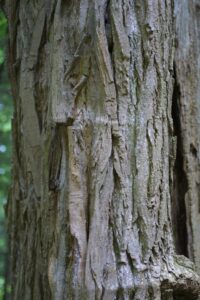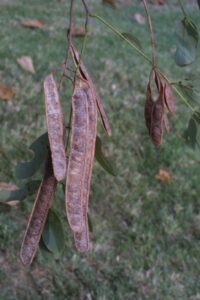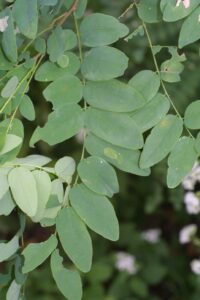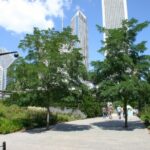Botanical Name:
Robinia pseudoacacia
Family Name:
Fabaceae / Pea
Description:
The black locust is a rapidly growing tree that will produce offshoots along its roots. Risks should be reviewed before selecting these trees for planting sites due to a tendency to be invasive, being poisonous if ingested by animals, having large thorns, and having brittle branches that can break off in the wind. Black locusts produce hanging clusters of fragrant white flowers in spring.
Size:
30-50′
Habitat and Range:
The black locust is incredibly adaptive and can grow at many elevations and in many microclimates and soil types. The pervasive nature of this tree makes for high maintenance care in ornamental environments. The tree is native to eastern and southern parts of the United States.
Attributes:
Ridged and furrowed dark gray bark complement compound bluish green leaves. In the spring, large drooping clusters of fragrant, creamy white clusters provide a wonderful visual and olfactory experience. As this tree is part of the pea family, the fruit is a 4 in long paper-like pod with red-brown seeds inside. Most parts of this tree contain toxic chemicals that are poisonous. In the fall, leaves turn an uneventful yellow. The tree develops new shoots from its roots, which causes this tree to be considered pervasive and can present a maintenance problem. Be warned, this tree has large spines at the base of leaves and on new growth.
Wildlife Value:
The beautiful flowers of the black locust are valuable food sources for honeybees. Deer and rabbits eat from the tree, and ruffed grouse consume the leaves. Squirrels and game birds eat the black locust seeds. Black locusts provide many cavities for dependent wildlife and the stems remain erect after the tree has died making it a long-lasting resource. Many bats and birds roost and nest within the cavities including the endangered Indiana bat and species of owl. Black locusts can also provide hiding and winter cover for deer, coyote, porcupine, skunks, rabbits, birds, and snakes.
Did you Know?
• The black locust fixes nitrogen from the soil allowing it to grow an impressive 3-4 feet per season.
• Just a ½ lb. of leaves or bark can kill a 1,000 lb. horse.
• The black locust wood is extremely resistant to rotting and was used to erect the first buildings during the founding of Jamestown—America’s first permanent English colony.
• A cord of seasoned locust has the same BTU as a ton of anthracite coal.
Benefits to Our Community (based on carbon dioxide sequestered, storm water runoff avoided, and air pollution removed each year):
Over the next 15 years, this tree will give back $2,310 worth of benefits to our community.




